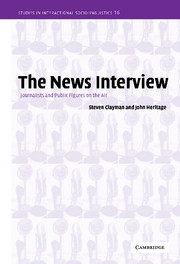Book contents
- Frontmatter
- Contents
- Acknowledgments
- 1 Introduction
- 2 The news interview in context: institutional background and historical development
- 3 Openings and closings
- 4 Basic ground rules: taking turns and “doing” news interview talk
- 5 Defensible questioning: neutralism, credibility, legitimacy
- 6 Adversarial questioning: setting agendas and exerting pressure
- 7 Answers and evasions
- 8 The panel interview: discussion and debate among interviewees
- 9 Conclusion
- Appendix: transcript symbols
- References
- Subject index
- Index of names
4 - Basic ground rules: taking turns and “doing” news interview talk
Published online by Cambridge University Press: 23 November 2009
- Frontmatter
- Contents
- Acknowledgments
- 1 Introduction
- 2 The news interview in context: institutional background and historical development
- 3 Openings and closings
- 4 Basic ground rules: taking turns and “doing” news interview talk
- 5 Defensible questioning: neutralism, credibility, legitimacy
- 6 Adversarial questioning: setting agendas and exerting pressure
- 7 Answers and evasions
- 8 The panel interview: discussion and debate among interviewees
- 9 Conclusion
- Appendix: transcript symbols
- References
- Subject index
- Index of names
Summary
In June 1973, John Ehrlichman, recently fired from President Richard Nixon's White House staff, was interviewed by Mike Wallace on CBS's 60 Minutes. The drumbeat of criticism of White House crimes and misdemeanors that would eventually topple the President was then intensifying and Ehrlichman's firing was only one of the most recent, and desperate, of Nixon's responses. As the camera moved into a tight close-up of Ehrlichman's face, Wallace intoned the litany of White House wrong-doing: “Plans to audit tax returns for political retaliation. Theft of psychiatric records. Spying by undercover agents. Bogus opinion polls. Plans to fire bomb a building. Conspiracy to obstruct justice. All of this by the law and order administration of Richard Nixon.” Eight long seconds passed as the camera focused on a stony-faced Ehrlichman. Then, with a slight smirk, he responded: “Is there a question in there somewhere?” Here, in the midst of the most serious crisis for the White House this century, Ehrlichman focused not on the substantive issues raised by Wallace, but on whether they had been appropriately expressed – in the form of a question.
Nothing could be more obvious than the fact that news interviews are made up of questions and answers. Yet it is this unremarkable fact that is central to the way that interview talk is organized. The question–answer format of news interviews is central to their structure and crucial to analyzing their dynamics in at least three ways.
Information
- Type
- Chapter
- Information
- The News InterviewJournalists and Public Figures on the Air, pp. 95 - 149Publisher: Cambridge University PressPrint publication year: 2002
